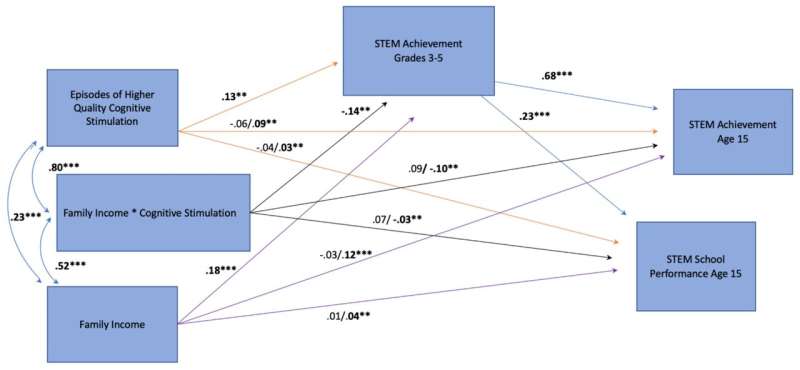This article has been reviewed according to Science X's editorial process and policies. Editors have highlighted the following attributes while ensuring the content's credibility:
fact-checked
peer-reviewed publication
trusted source
proofread
High-quality child care found to contribute to later success in science, math

Children who receive high-quality child care as babies, toddlers and preschoolers do better in science, technology, engineering and math through high school, and that link is stronger among children from low-income backgrounds, according to research published by the American Psychological Association.
"Our results suggest that caregiving quality in early childhood can build a strong foundation for a trajectory of STEM success," said study author Andres S. Bustamante, Ph.D., of the University of California Irvine. "Investing in quality child care and early childhood education could help remedy the underrepresentation of racially and ethnically diverse populations in STEM fields."
The research was published in the journal Developmental Psychology.
Many studies have demonstrated that higher quality caregiving in early childhood is associated with better school readiness for young children from low-income families. But not as many have looked at how the effects of early child care extend into high school, and even fewer have focused specifically on STEM subjects, according to Bustamante.
To investigate those questions, Bustamante and his colleagues examined data from 979 families who participated in the National Institute of Child Health and Human Development Study of Early Child Care and Youth Development, from the time of the child's birth in 1991 until 2006.
As part of the study, trained observers visited the day cares and preschools of all the children who were enrolled for 10 or more hours per week. The observers visited when the children were 6, 15, 24, 36 and 54 months old, and rated two aspects of the child care: the extent to which the caregivers provided a warm and supportive environment and responded to children's interests and emotions, and the amount of cognitive stimulation they provided through using rich language, asking questions to probe the children's thinking, and providing feedback to deepen the children's understanding of concepts.
The researchers then looked at how the students performed in STEM subjects in elementary and high school. To measure STEM success, they examined the children's scores on the math and reasoning portions of a standardized test in grades three to five. To measure high school achievement, the researchers looked at standardized test scores and the students' most advanced science course completed, the most advanced math course completed, GPA in science courses and GPA in math courses.
Overall, they found that both aspects of caregiving quality (more cognitive stimulation and better caregiver sensitivity-responsivity) predicted greater STEM achievement in late elementary school (third, fourth and fifth grade), which in turn predicted greater STEM achievement in high school at age 15. Sensitive and responsive caregiving in early childhood was a stronger predictor of high school STEM performance for children from low-income families compared with children from higher income families.
"Our hypothesis was that cognitive stimulation would be more strongly related to STEM outcomes because those kinds of interactions provide the foundation for exploration and inquiry, which are key in STEM learning," Bustamante said. "However, what we saw was that the caregiver sensitivity and responsiveness was just as predictive of later STEM outcomes, highlighting the importance of children's social emotional development and settings that support cognitive and social emotional skills."
Overall, Bustamante said, research and theory suggest that high-quality early care practices support a strong foundation for science learning. "Together, these results highlight caregiver cognitive stimulation and sensitivity and responsiveness in early childhood as an area for investment to strengthen the STEM pipeline, particularly for children from low-income households."
More information: Andres S. Bustamante et al, Quality of early childcare and education predicts high school STEM achievement for students from low-income backgrounds., Developmental Psychology (2023). DOI: 10.1037/dev0001546. www.apa.org/pubs/journals/rele … s/dev-dev0001546.pdf
Journal information: Developmental Psychology
Provided by American Psychological Association




















